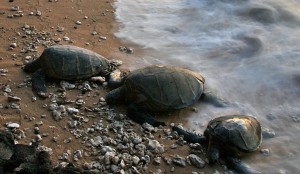
**IMPORTANT PARK NOTICES**
Monitor weather reports before your park visit.
•
[KAUA’I] UPDATE 12/18/25 Kalalau trail has REOPENED.
•
[OʻAHU] UPDATE 12/15/25 — Ka\'ena Point State Park: Mokulē\'ia Section Vehicle Access Gate is temporarily CLOSED due to saturated road conditions.
•
[ALL ISLANDS] UPDATE – 12/12/25: Camping - Reservations for February 1, 2026 and beyond available at https://explore.ehawaii.gov, please create an account on Explore Outdoor Hawaiʻi to make a camping reservation.
Sea Turtles
Posted on Oct 23, 2014Hawaiʻi hosts several species of sea turtles, but by far the most commonly seen is the Green Sea Turtle (honu). These large, gentle marine reptiles, typically 2-3 feet in shell length, frequent calm bays and shallow offshore reefs and lava shelves in Hawaiʻi where they feed on seaweed (limu). These turtles (which are actually dark brown in color) do come ashore regularly to bask and lay their eggs, although very few nest in the main islands. Most Hawaiian Green Sea Turtles migrate 800 miles north to mate and nest in the Northwest Hawaiian Islands on the sandy shores of French Frigate Shoals.
In the main islands , Green Sea Turtles are rarely seen in large numbers. They prefer isolated, uncrowded beaches, so they are difficult to view reliably. There are significant populations along Kauaʻi’s Nāpali Coast State Wilderness Park, where they can also be viewed via coastal boat tours. There are also viewing opportunities within parks along the Big Island’s Kona Coast. From shore they are most easily recognized when they surface to breathe, but can also be seen feeding on the shallow sea bottom. If you are in a vessel or swimming, diving or snorkeling and encounter a swimming turtle, give them a wide berth so as not to disturb them.
Hawaiʻi’s sea turtles are protected species’, and persons are strongly advised to maintain adequate distance (minimum 50 yards/45 meters) so as not to disturb them. Though they spend most of their time in the water, they frequently haul out to rest or ride out storms and this is normal behavior. Approaching a resting turtle may cause it to re-enter the ocean and compromise its safety. For more info, visit https://dlnr.hawaii.gov/dar/species/sea-turtles/



